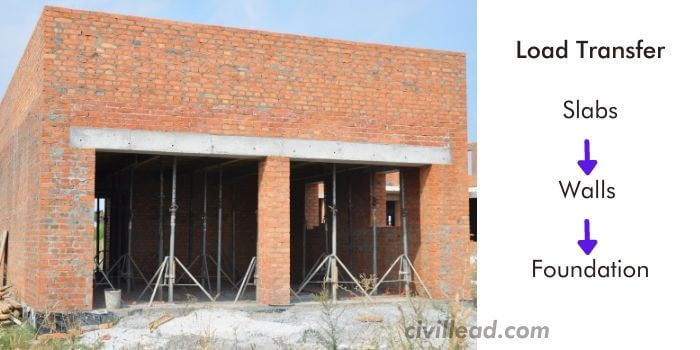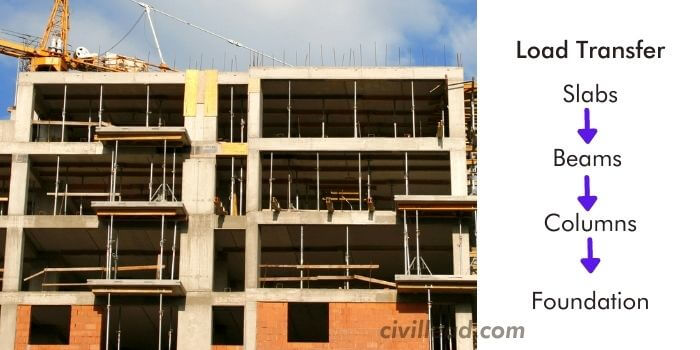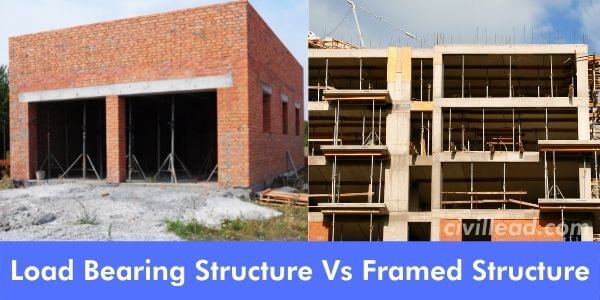Table of Contents
What is Building Structure?
The structure of a building can be subdivided into three parts.
- Substructure,
- Plinth,
- Superstructure.
The structure’s portion that is beneath the ground level refers to the substructure. The part above the ground floor level refers to the superstructure.
The part over the ground level and beneath the ground floor level is called a plinth.
It includes various building elements such as walls, doors & windows. There are three types of structure.
- Load Bearing Structure,
- Framed Structure,
- Composite Structure
Load Bearing Structure
A structure in which loads are transferred through walls to the foundation refers to a load-bearing structure.
In this type of structure, loads from the slabs are transferred to the walls, then moved to the foundation. These structures don’t have columns and beams.
Load-bearing walls are built over a continuous foundation. They are planned to carry the entire load, including their load.
Hence in this type of structure, beams, slabs, truss rest on a load-bearing wall.

Load-bearing structures were preferred for the construction of small houses and low-rise buildings in earlier days. But nowadays, they are rarely adopted.
These structures are suitable for the construction of buildings up to two floors only.
Load-bearing structures have building components that safely carry and transfer loads to the ground; this structure guarantees the building’s stability and performance.
Such a system is used in the construction of residential buildings having small room sizes. Load bearing structure is economical for residential and commercial buildings up the second floor.
This system comprises thick brick or stone masonry supporting the whole structure, including slab, floor slab made of wood, steel, and reinforced cement concrete.
Framed Structure
The columns are erected on their independent foundation in this type, braced together by beam and slab.
The space between column and beam is filled up by panel wall as per requirement. The panel wall has to carry its weight, and it acts as a partition wall or the external wall or room.
The frame carries the entire load of the structure. The cost of the frame is about 40% of the total construction cost.

Composite structures
It is the combination of the above two types. In this type, the outer walls may be load-bearing, and the intermediate support may be columns. The roof is supported by a beam resting on load-bearing walls and columns.
Analysis of Load Bearing Structure
- Initially, the whole structure is analysed, and the function of each member is defined.
- Then the load on each structural member is calculated.
- Along with the forces that they transfer, external forces that are affecting the structural members are determined.
- The forces within the structural components are internal.
- Then the stability of the entire structure is determined.
- Lastly, it is proved that the prepared structure will resist all the forces coming over it.
Load Bearing Member of A Structure
Load Bearing Walls
This wall transfers the loads from the slab over it to the foundation. These can be constructed of brick or stone masonry, block materials and concrete.
In a building structure, most of the exterior walls are considered load-bearing. Before Replacing these walls for renovation purposes, alternative support must be provided for the member resting over them.
Beams
Beams are the essential load-bearing structural members that can be made of wood, steel and concrete.
It is primarily employed to carry the load of the building. Its load-carrying capacity depends on its width and length. They are subjected to heavy compressive and shear forces.
Column
It is one of the essential structural members that play a vital role in transferring the dead and live load of the building to the foundation.
Braces
It is an essential framework structural member helps to make framework stiffen making them rigid.
Trusses
Trusses are the load-bearing member that supports the roof in a structure of the building. Load from the top uniformly distributed to the truss. They are subjected to tension and compression forces but not any moment.
Advantages of Load Bearing Structure
- These structures offer excellent fire resistance.
- It has a thicker load-bearing wall that provides good sound insulation.
- The construction materials required for these structures are economical.
- The construction process of these structures is simple and doesn’t need time-consuming preparation.
- These structures provide excellent strength and durability to the house.
- Load-bearing systems are less costlier as compared to frame structures for less than three floors.
Disadvantages
- These structures are constructed with brick or stone masonry that offers poor resistance against earthquakes.
- These types of systems provide less carpet area due to thicker walls.
- These structures have span limitations, and larger room sizes may not be constructed with these structures.
- Repositioning of internal walls is challenging in these structures.
- This structural system allows limited numbers of storeys.
- This structural system is more labour-intensive and has poor construction speed.
Difference Between Load Bearing Structure and Framed Structure

| S.No. | Load Bearing Structure | Framed structure |
|---|---|---|
| 1 | These structures transfer loads through the walls to the foundation. | In Frame, structure loads transfer through beams, columns to the foundation. |
| 2 | The load-bearing structure offers less carpet area due to thicker walls. | Frame structure provides a large carpet area due to the lower thickness of the wall. |
| 3 | Load-bearing designs are not suitable for any soil. | Frame structures are ideal for any soil. |
| 4 | It is ideal for up to two floors only. | It is suitable for any number of floors. |
| 5 | It provides slow construction. | It gives faster construction. |
| 6 | It can’t resist earthquake shocks. | It can withstand earthquake shocks. |
| 7 | The construction cost of these structures is less. | The construction cost of these structures is more. |
| 8 | Repositioning of walls to meet the requirement at any time is not possible due to load-bearing walls. | Repositioning of walls to meet the demand at any time is possible. |
| 9 | There is a span limitation in this structure. | There is no span limitation in these structures. |
| 10 | The cantilever is challenging in this type of structure. | The cantilever is easily achievable in this type of structure. |
| 11 | This system has limitations for opening affecting light and ventilation. | This system has no restrictions for opening. |
| 12 | This system doesn’t require plants and machinery for the construction compared to the frame structure. | This system needs plants and machinery for construction. |
| 13 | This structure is more labour-intensive. | This structure is less labour-intensive but requires skilled labours. |
| 14 | In this system structure’s life is less affected due to work technique. | In this system structure’s life is reduced if not performed as per specifications. |
Final Words
Load-bearing structures are older construction practices. Frame structures have columns and beams, offer excellent resistance to lateral forces, and are more flexible than load-bearing structures.
Also, Read
Load Calculation on Column – Load Calculation of Column, Beam, Wall & Slab
Difference Between Lap length and Development Length
Monolithic Slab Vs Floating Slab
Sunken Slab – Uses, Advantages & Disadvantages
What is Slab Beam|Flat Beam|Hidden Beam|Concealed Beam?
Cracks in Concrete Slab – Why do they develop after casting?